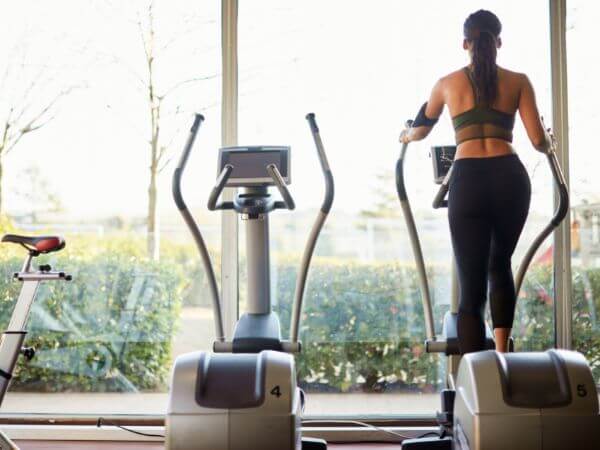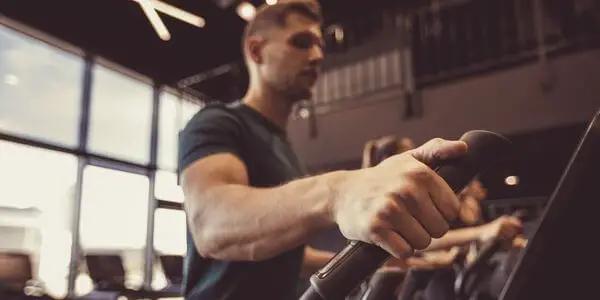Ellipticals are a great way to get in a good workout, but sometimes it’s hard to know which muscles you’re working.
When trying to stick to a regular workout routine, it’s important to target all the right muscles. If you’re unsure which muscles an elliptical works, you might be tempted to skip your workout altogether.
An elliptical can target all your key muscle groups.
And it boasts two unique selling points. Keep reading below to discover why these machines may be better for you than other fitness equipment.
But first:
Table of Contents
Muscles Worked by Ellipticals
Let’s first start with the muscles primarily targeted while exercising on an elliptical:
Lower Body

An elliptical is a low-impact machine that simulates the natural motion of your legs. As such, it’s a great way to target all the key muscle groups in your lower body, including your:
- Quadriceps
- Hamstrings
- Calves
- Glutes
Some sources claim that pedaling away on the elliptical engages your hamstrings and calves more than your quads – unlike exercise bikes, for example. Other sources contradict this opinion, stating that ellipticals make your quads and glutes work harder.
So what’s the truth?
If we’re to think logically, the answer is that both exercise bikes and ellipticals engage all the key muscle groups in your lower body to some degree.
However, it’s worth noting that the way you use an elliptical can make a difference.
- If you keep your feet low on the pedals and push down with more force, you’re likely to feel it more in your quads.
- On the other hand, if you keep your feet high on the pedals and focus on a longer, more controlled stroke, you’re likely to feel it more in your hamstrings.
Here are two other tips to consider:
- Want an increased focus on the front of your leg? Choose an elliptical with an incline. It will feel like a combination of walking and cycling uphill, which will torch your quads. You’ll feel it quite a lot on your inner and outer thighs.
- Want an increased focus on your hamstrings? Start pedaling backward. This movement engages the back of your thighs, strengthening your hamstrings, calves, and glutes.
Is there any secret to getting better glutes from an elliptical? Of course: use the resistance! The higher the resistance, the more work your glutes have to do. If you’re new to exercise, start with lower resistance and gradually increase it over time.
Upper Body

While most people focus on their lower body when using an elliptical, don’t forget that this machine can also give your upper body a kicking.
How?
Well, most ellipticals come with moving handles you can hold on to while pedaling. As you push and pull the handles, you target your:
- Arms
- Shoulders
- Chest
- Back
This motion is a great way to tone your arms and shoulders and improve your upper body strength. However, remember to keep your core engaged to avoid straining your lower back.
Here’s how that works:
- When pushing a hand forward, you activate the front of your shoulders, biceps, and chest muscles.
- When pulling a hand back, you’re working your triceps and the back of your shoulders.
But there’s a catch:
Simply holding onto the handlebars doesn’t provide much resistance.
While ellipticals have different resistance levels:
- Cheaper models don’t usually go very high. You also won’t feel much difference between the lowest and the highest setting.
- That resistance is just for the lower body, not your arms – even for gym-quality ellipticals.
Here are some solutions:
- Some ellipticals come with resistance bands that you can use to target your arms and upper body even more. These are great if you want to add some variety to your routine.
- You can attach 1-2-pound wrist weights to your wrists, thus creating more resistance artificially.
- You can contract your arm muscles if you don’t have those weights.
- Alternatively, give your legs a break and start pushing with your arms. See how that movement activates the pedals and moves your legs. Start alternating between intervals. Of course, you’ll need increased focus for this motion because our instinct is to pedal with our legs, not our arms. Luckily, focusing on your workout has been proven to increase brain plasticity and working memory, so you’ve got that going for you.
If neither of the above sounds good, remember you can’t work out on the elliptical daily. So, dedicate those “pause” days to your upper body. Consider strength, bodyweight, or resistance training.
Core

The core is your body’s powerhouse, so it’s essential to keep it strong. A strong core helps you with daily activities, reduces the risk of injuries, and can improve your posture.
Fortunately, using an elliptical also works for your core muscles.
How?
Since you have to maintain balance while pedaling, your body must engage your core muscles to stay upright.
This is especially true if you use an elliptical with no handlebars. In this case, you must engage your abs/lower back even more to maintain balance and stability.
Here’s a tip: try pedaling backward for greater engagement of your core muscles.
The problem, of course, is that an elliptical doesn’t target your core as well as crunches, back bows, or weighted lunges (yes, that last one isn’t here by mistake; with the proper weight, these lunges can fire up your lower abs and obliques like none other).
Solutions include:
- Keep your core engaged during your elliptical workout to ensure your abs are activated more comprehensively.
- Try to exaggerate the twisting motion to target your obliques more.
- Don’t hunch over the handlebars because that would hurt your lower back.
- Tie a fitness sandbag around your shoulders to build more functional strength in your back. However, if you’re using a sandbag, you should keep your posture straight and go at a low speed/high resistance. Otherwise, going too fast when you’re a beginner increases your injury risk.
The Two Unique Selling Points

Now that you’re here, you understand the benefits of an elliptical and have a clearer picture of how this machine can do wonders for your muscles.
What are the two unique selling points we’ve been drumming up since the intro?
Firstly, the elliptical offers resistance training at a low impact. Few machines can do that. Besides, many people imagine resistance training should entail heaving weights or endless push-ups.
Ellipticals prove that’s not the case.
All you have to do is set the right program.
- The second advantage is even better: ellipticals allow you to make a circular motion with both your hands and legs. The consequences for your body are remarkable:
- Your joints get a great workout too. And as you know, joint health is essential to building more muscle because damaged joints can kill your gains.
- You target some frequently ignored muscle groups, such as the muscles in your hips or rotator cuffs. Although nobody Googles “how to get your hip flexors beach ready,” these babies are as crucial as your glutes.
- You work more muscles simultaneously, thus burning more calories and saving time. While your left leg’s quads push the pedal forward, your right hamstring and calf are getting engaged too. While your left arm’s triceps are activated, your right arm’s biceps are getting a good workout.
- The perceived effort is lower. This rotation movement and using different muscle groups simultaneously make your workout feel easier. The reason is that you’re intermittently giving some muscles a break while focusing on others.
It might sound like we’re gushing, but it’s true: an elliptical is one of the most efficient machines for your home gym.
To make the most of your workout, we recommend that you:
- Warm up for 5 to 10 minutes before starting your elliptical session.
- Start slowly and increase the resistance/speed/incline gradually.
- Don’t go too fast; focus on quality over quantity.
- Try to incorporate high-intensity interval training (HIIT) into your routine. If your elliptical doesn’t have at least one HIIT program, you can find a host of them on YouTube. You can also learn to build your own once you get more experience.
- Cool down for 5 to 10 minutes after your elliptical session.
If you follow these tips, we guarantee you’ll see results in no time!
- 7 Exercises for Pregnant Women in the First Trimester: Safe and Effective - January 30, 2025
- Our equipment recommendations - October 30, 2024
- Here’s What Doing Cardio Every Day Does To Your Body - August 21, 2024

